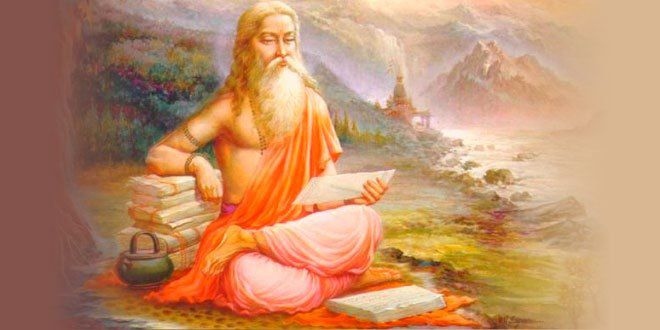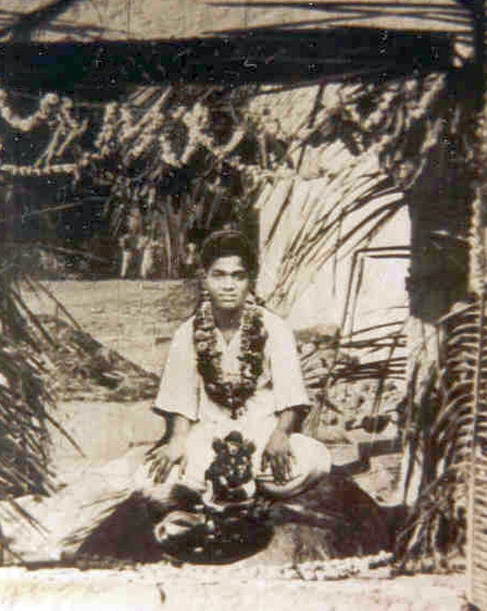 Guru Purnima is the festival of the guru; it is also known as Vyasa Purnima, as this is the day that Sage Vyasa completed dictating the Bhagavad Gita. On the festival of Guru Purnima, we were asked, ‘What is a guru, What is a Swami?’ We take some space here to consider Sanyasin, Swami, Acharya and Guru.
Guru Purnima is the festival of the guru; it is also known as Vyasa Purnima, as this is the day that Sage Vyasa completed dictating the Bhagavad Gita. On the festival of Guru Purnima, we were asked, ‘What is a guru, What is a Swami?’ We take some space here to consider Sanyasin, Swami, Acharya and Guru.
What is a Sanyasin?
Sannyasin is a Sanskrit word that describes someone who has reached the life stage of sannyasa, or “renouncement of material possession.”
A sannyasin has turned away from all material possessions and emotional ties. They now live only to perfect their understanding of the spiritual world. This is seen as a state of sacrifice that leads to final liberation from the cycle of death and rebirth, or moksha.
For many advanced yogis, becoming a sannyasin is the final stage of yoga practice. They can devote themselves wholly to the pursuit of the spiritual understanding that comes from yoga.
A sannyasin doesn’t worry about the clothes they wear or what food they will eat tomorrow. Instead, they are only concerned with understanding the inner Self. Often wearing orange or yellowish-coloured clothing, they lead an itinerant lifestyle.
Not everyone who practices yoga will go on to become a sannyasin
What is a Swami?
A swami is a spiritual teacher, guru or master whose objective is to master the self through renunciation, which includes setting aside temporal and secular ambitions to pursue a life of spiritual realisation. Within yoga, highly regarded spiritual teachers may receive the title of swami by followers or others in the community.
In Sanskrit, swami means “one who knows.”
Many practising swamis consider the lifestyle to be a journey of self-sacrifice, rather than a decision to simply become a spiritual master who follows a certain protocol. As swamis follow a path of renunciation, they serve others as spiritual teachers.
Although many swamis consider themselves to be Hindu, some choose not to associate with a specific religion. Teachers within the yoga community who have the title of swami are not associated with a specific religion, but are considered to be part of a devout spiritual yoga community.
Difference between Swami and Guru
If your worldly bonds are not cut, you will be born in the cycle of animals and worms. This is a loss to you. If you attain Kaivalyam, it is a benefit. Even if there is no benefit, there should at least be no loss to you. Even if you are not able to attach yourself to the Lord, at least you should cut the worldly bonds and get human rebirth. But there is no use of the salvation (moksha) without the Kaivalyam. If you simply maintain your present status, there is no use. What is the use of selecting the best doctor unless you follow his prescription in practice? Similarly even if you have caught the real Sadguru, who is the incarnation of the Lord there is no use if you do not follow His instructions. You cannot get rid of the illness by praising the doctor or his prescription. Similarly there is no use of praising the Lord unless you practice the preaching of the Lord. Avoiding the forbidden food [contraindicated food] is salvation. Taking the medicine is Kaivalyam. Salvation involves Vairagym (detachment) and Kaivalyam involves Bhakti (devotion). Source: http://living-smartly.com/2014/02/guru-swami-yogi-difference/
What is the difference between a Guru, Sadguru and Acharya?
The word Guru means one who dispels darkness – a teacher.
The word Acharya means one who teaches the right conduct – again a teacher, basically.
But other than the straight meaning, in Hinduism both Guru as well as Acharya are associated with a master to whom a religious/ spiritual aspirant goes and seeks guidance in the matter of divine/ spiritual/ adyatma knowledge.
In certain sampradayas (traditions) (e.g. Vaishnava), the master is referred to as Acharya rather than Guru.
Again there are finer differences. Read more here
The Guru: one who takes you beyond
The immediate Guru is our visible Master. To us, of course, it is Worshipful Gurudev Sri Swami Sivanandaji Maharaj, and others may have devotion to their own Masters who are visible guides to them in this world. But behind the visibility of the Guru, there is an invisibility which is the real soul of the Guru. The Guru, the Master, the spiritual preceptor or the divine presence is not to be regarded as an external reality in front of us which we can photograph with a camera. We have to be a little cautious in our understanding of the meaning of the word ‘Guru’. It is a Master’s presence which overcomes us, overwhelms us, rises above us, transcends us, engulfs us, and includes us in its presence.
The higher is not merely the external. The Guru is a higher presence, and not an external schoolmaster whom we can see seated on a chair in an educational institution. He may be that also, but there is a difference between a Guru and a schoolmaster. The Guru is a spiritual presence. The spirituality implied in the presence of the Guru makes the Guru a presence that involves us in its total existence. The Guru is above us. The aboveness of the Guru, or the spiritual presence, is a proper explanation for why the Guru is not merely an external personality. In that sense, our Guru never dies. It is a perpetual presence. Vyasa, Nara-Narayana, and Worshipful Swami Sivanandaji Maharaj are presences. A spiritual presence cannot vanish. It has to be there in some degree. When it is physically invisible, it becomes more potent by the rarefied form it takes as a power and not merely as a visible object.
In our meditations and prayers we often find it difficult to conceive what this presence is, and on what we are contemplating. We have an inveterate habit of imagining that all things are outside us, even God Himself. Though we may accept that God Almighty is the Creator of the universe, the idea of an outsideness of His presence seeps into our consciousness, and we cannot easily accommodate ourselves to the requirement that all superphysical realities are also transcendent in their nature. The word ‘transcendence’ negates its externality.
Now, a Guru or a Master, a spiritual presence representative of God Almighty, being transcendent, involves us in its presence. When automatic shaktipada takes place, as it were, as put in language, the Guru enters us. The external cannot enter us because externality keeps the two terms of relation apart from each other. But the Guru is not such a term of relation which is purely outside in space and time. Here is the essence of the spirituality behind the Guru, who does not exist merely as a person before us. The Guru is not a person, but a super-person. The super-personality of the Guru is the divinity thereof; so is Bhagavan Krishna Dvaipayana Vyasa, so is Nara-Narayana, and so is every degree of manifestation before us of God Almighty Himself.

You have heard that the Lord comes down when Dharmaglani or the Decline of Dharma happens; well, Vedaglani or the Decline of the Vedas is equivalent to the decline of Dharma, for Veda is the very root of Dharma. There are five treasures which the good always try to guard, and which you should endeavour to foster: the Cow, the Brahmin, the Vedas, the Sastras, and Chastity. If these are lost, then, life is lost; everything that adds value to life is lost. Where there is Dharma, there Krishna is; so, think for yourself, each one of you. How far have you deserved the Grace of the Lord? You draw Him near; you keep Him far. You entangle yourself, bind yourself, and get caught in the trap. No one is your foe except yourself. No one else is your friend; you are your only friend. The Guru shows you the road; you have to trudge alone, without fear or hesitation. 24-3-1963
When Sankara thought of renouncing the world (in order to get the authority to educate it) he felt that his mother’s consent had to be taken for the step. So, while bathing in the Poorna River near his house, he cried out one day that a crocodile had caught his leg. It was true, for the crocodile was, as in the Gajendramoksha story, only Samsara called by that name, sensual desire, to put it in other words. When the mother came rushing to the bank of the river, he told her that the crocodile would let him off, only if he took Sanyasa, became a Monk! This was also true, for, renunciation, detachment, giving up worldly ties, is the means of saving oneself from bondage. The bewildered mother agreed and the boy left home to seek his Guru, and through him the secret of liberation. Sankara Jayanthi 28-4-63
Like the silk-worm that spins from out of itself the cocoon that proves to be its tomb, man spins from out of his own mind the cage in which he gets trapped. But there is a way of escape, which the Guru can teach you or which the God in you will reveal to you. Take to the Sadhana which will bring relief. Away with the roles of clown and clout, which you have acted all these ages. Take on the role of the hero, not that of Zero! Forget the past, do not worry about possible errors or disappointments. Decide and do.
There are some gurus who advise you to keep a daily diary, where you note town every item of evil that you did; they ask you to read it as a spiritual exercise ant resolve to correct yourself. Well, reading it, and writing it will only tend to impress it more effectively on the mind. It is better to substitute good thoughts for the bad and cleanse the mind of all evil by dwelling on righteous deeds and holy thoughts. Forget the things that you do not want to remember. Bring to memory only those things that are worth remembering. That is the sane way to achieve spiritual progress. Prasanthi Nilayam 1-1-64
The very first lesson I gave when I declared My Identity at Uravakonda was: “Maanasa bhajare guru charanam; dusthara bhava saagara tharanam.” That is to say, first know that you are in bhavasaagaram, this cycle of birth and death; then, resolve on ‘tharanam‘, crossing it; then fix on a Guru or the Name and Form of God which appeals to you; lastly, dwell on His Glory, do bhajan, but do it with all your mind. He who is deluded by this relative reality is the Samsari; he who is aware that it is only relatively real is the Sadhaka.

![]()

